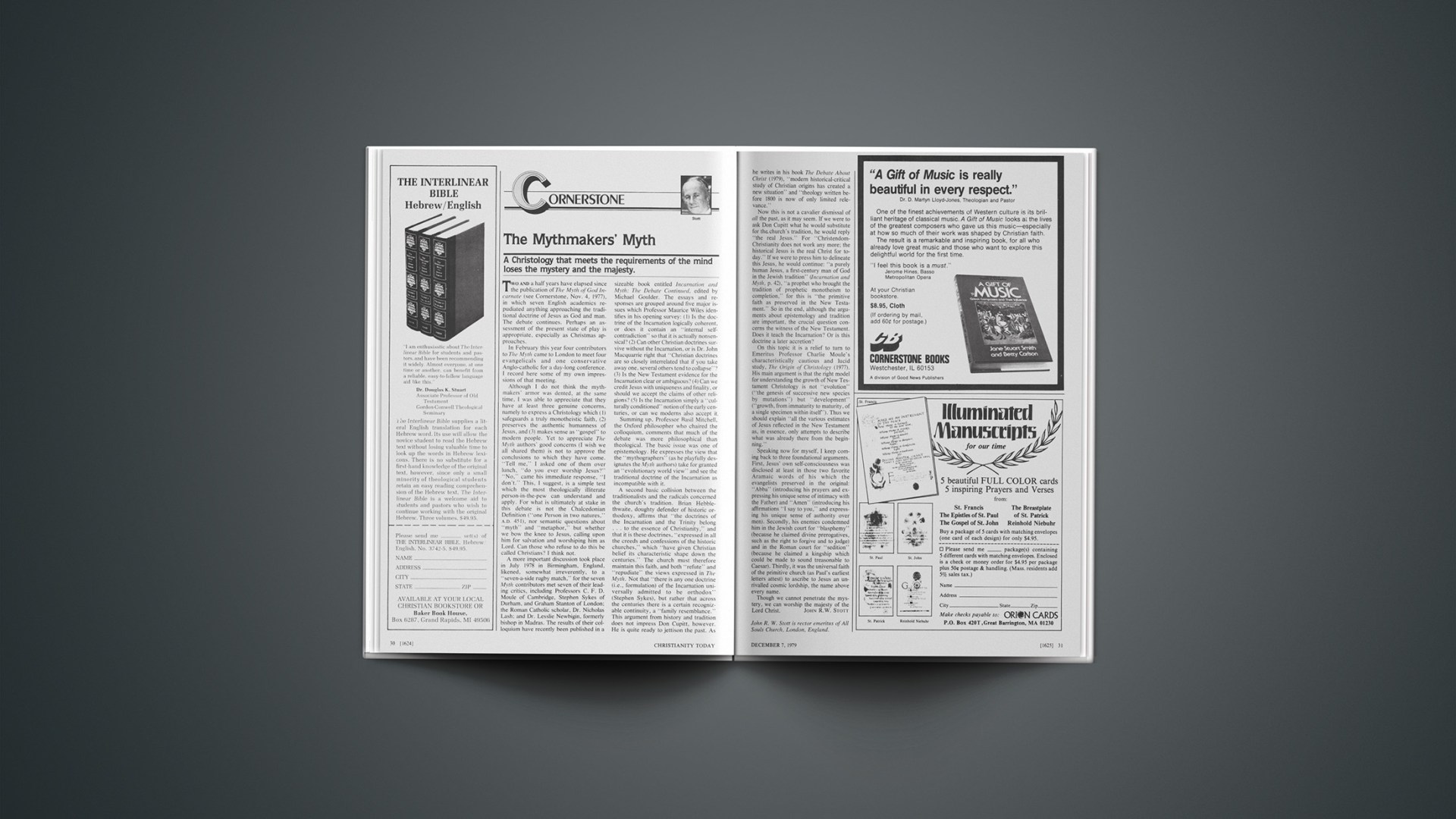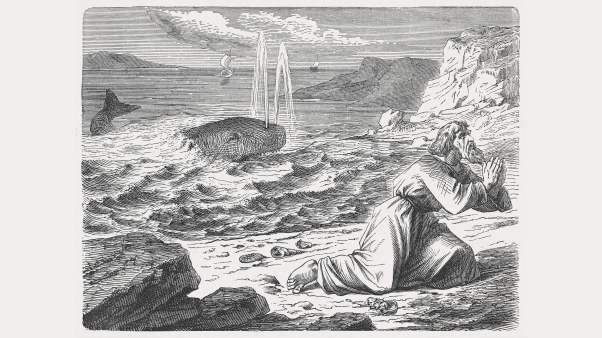A Christology that meets the requirements of the mind loses the mystery and the majesty.
Two and a half years have elapsed since the publication of The Myth of God Incarnate (see Cornerstone, Nov. 4, 1977), in which seven English academics repudiated anything approaching the traditional doctrine of Jesus as God and man. The debate continues. Perhaps an assessment of the present state of play is appropriate, especially as Christmas approaches.
In February this year four contributors to The Myth came to London to meet four evangelicals and one conservative Anglo-catholic for a day-long conference. I record here some of my own impressions of that meeting.
Although I do not think the myth-makers’ armor was dented, at the same time, I was able to appreciate that they have at least three genuine concerns, namely to express a Christology which (1) safeguards a truly monotheistic faith, (2) preserves the authentic humanness of Jesus, and (3) makes sense as “gospel” to modern people. Yet to appreciate The Myth authors’ good concerns (I wish we all shared them) is not to approve the conclusions to which they have come. “Tell me,” I asked one of them over lunch, “do you ever worship Jesus?” “No,” came his immediate response, “I don’t.” This, I suggest, is a simple test which the most theologically illiterate person-in-the-pew can understand and apply. For what is ultimately at stake in this debate is not the Chalcedonian Definition (“one Person in two natures,” A.D. 451), nor semantic questions about “myth” and “metaphor,” but whether we bow the knee to Jesus, calling upon him for salvation and worshiping him as Lord. Can those who refuse to do this be called Christians? I think not.
A more important discussion took place in July 1978 in Birmingham, England, likened, somewhat irreverently, to a “seven-a-side rugby match,” for the seven Myth contributors met seven of their leading critics, including Professors C. F. D. Moule of Cambridge, Stephen Sykes of Durham, and Graham Stanton of London; the Roman Catholic scholar, Dr. Nicholas Lash; and Dr. Lesslie Newbigin, formerly bishop in Madras. The results of their colloquium have recently been published in a sizeable book entitled Incarnation and Myth: The Debate Continued, edited by Michael Goulder. The essays and responses are grouped around five major issues which Professor Maurice Wiles identifies in his opening survey: (1) Is the doctrine of the Incarnation logically coherent, or does it contain an “internal self-contradiction” so that it is actually nonsensical? (2) Can other Christian doctrines survive without the Incarnation, or is Dr. John Macquarrie right that “Christian doctrines are so closely interrelated that if you take away one, several others tend to collapse”? (3) Is the New Testament evidence for the Incarnation clear or ambiguous? (4) Can we credit Jesus with uniqueness and finality, or should we accept the claims of other religions? (5) Is the Incarnation simply a “culturally conditioned” notion of the early centuries, or can we moderns also accept it.
Summing up, Professor Basil Mitchell, the Oxford philosopher who chaired the colloquium, comments that much of the debate was more philosophical than theological. The basic issue was one of epistemology. He expresses the view that the “mythographers” (as he playfully designates the Myth authors) take for granted an “evolutionary world view” and see the traditional doctrine of the Incarnation as incompatible with it.
A second basic collision between the traditionalists and the radicals concerned the church’s tradition. Brian Hebblethwaite, doughty defender of historic orthodoxy, affirms that “the doctrines of the Incarnation and the Trinity belong … to the essence of Christianity,” and that it is these doctrines, “expressed in all the creeds and confessions of the historic churches,” which “have given Christian belief its characteristic shape down the centuries.” The church must therefore maintain this faith, and both “refute” and “repudiate” the views expressed in The Myth. Not that “there is any one doctrine (i.e., formulation) of the Incarnation universally admitted to be orthodox” (Stephen Sykes), but rather that across the centuries there is a certain recognizable continuity, a “family resemblance.” This argument from history and tradition does not impress Don Cupitt, however. He is quite ready to jettison the past. As he writes in his book The Debate About Christ (1979), “modern historical-critical study of Christian origins has created a new situation” and “theology written before 1800 is now of only limited relevance.”
Now this is not a cavalier dismissal of all the past, as it may seem. If we were to ask Don Cupitt what he would substitute for the church’s tradition, he would reply “the real Jesus.” For “Christendom-Christianity does not work any more; the historical Jesus is the real Christ for today.” If we were to press him to delineate this Jesus, he would continue: “a purely human Jesus, a first-century man of God in the Jewish tradition” (Incarnation and Myth, p. 42), “a prophet who brought the tradition of prophetic monotheism to completion,” for this is “the primitive faith as preserved in the New Testament.” So in the end, although the arguments about epistemology and tradition are important, the crucial question concerns the witness of the New Testament. Does it teach the Incarnation? Or is this doctrine a later accretion?
On this topic it is a relief to turn to Emeritus Professor Charlie Moule’s characteristically cautious and lucid study, The Origin of Christology (1977). His main argument is that the right model for understanding the growth of New Testament Christology is not “evolution” (“the genesis of successive new species by mutations”) but “development” (“growth, from immaturity to maturity, of a single specimen within itself”). Thus we should explain “all the various estimates of Jesus reflected in the New Testament as, in essence, only attempts to describe what was already there from the beginning.”
Speaking now for myself, I keep coming back to three foundational arguments. First, Jesus’ own self-consciousness was disclosed at least in those two favorite Aramaic words of his which the evangelists preserved in the original: “Abba” (introducing his prayers and expressing his unique sense of intimacy with the Father) and “Amen” (introducing his affirmations “I say to you,” and expressing his unique sense of authority over men). Secondly, his enemies condemned him in the Jewish court for “blasphemy” (because he claimed divine prerogatives, such as the right to forgive and to judge) and in the Roman court for “sedition” (because he claimed a kingship which could be made to sound treasonable to Caesar). Thirdly, it was the universal faith of the primitive church (as Paul’s earliest letters attest) to ascribe to Jesus an unrivalled cosmic lordship, the name above every name.
Though we cannot penetrate the mystery, we can worship the majesty of the Lord Christ.
John R. W. Stott is rector emeritus of All Souls Church, London, England.










